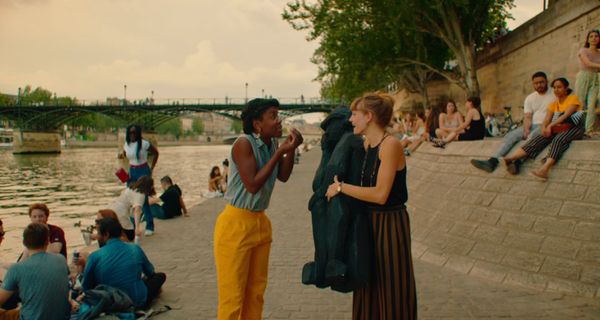 |
| Ambre (Aurore Déon) and Blanche (Noémie Schmidt) discuss Anish Kapoor’s black in Elisabeth Vogler’s hypnotic and momentous Roaring 20s (Années 20) |
The Tribeca Film Festival International Narrative Competition jury comprised of Alexander Payne, Melissa Leo, Delroy Lindo, Peter Scarlet, and Lesli Klainberg, awarded Best Cinematography in an International Narrative Feature Film to Elisabeth Vogler for Roaring 20s (Années 20) and the film, a highlight of the festival, received a Special Jury Mention for the ensemble (Alice de Lencquesaing, Margaux Bonin, Noémie Schmidt, François De Brauer, Joris Avodo, Mehdi Djaadi, Aurore Déon, Zoé Fauconnet, Elsa Guedj, Adil Laboudi, François Mark, Guillaume Pottier, Lila Poulet, Léo Poulet, François Rollin, Elie Salleron, Fanny Santer, Paul Scarfoglio, Vladimir Seguin, Manuel Severi) cast “for their characters and dialogue both written and improvised seamlessly that provide a portrait timeless and true.” Levan Koguashvili’s Brighton 4th, produced by Irakli Rodonaya, Olena Yershova, Michel Merkt, Kateryna Merkt won Best Film, Best Screenplay to Boris Frumin, and Best Actor to Levan Tediashvili. Best Actress went to Bassant Ahmed and Basmala Elghaiesh in Ayten Amin’s Souad.
 |
| Elisabeth Vogler: “Agnès Varda is one of my favourite filmmakers” |
Elisabeth Vogler’s hypnotic and momentous Roaring 20s, produced by Laurent Rochette (21 juin Cinéma) and Olivier Capelli (Les idiots), and co-written with Joris Avodo, François Mark, and Noémie Schmidt follows 24 characters in the summer of 2020 in one continuous take, starting at the Louvre through the streets of Paris, down to the Seine, into the Métro, up to Place de la République, via Belleville, to les Buttes Chaumont for a grand finale.
From New York City, Elisabeth Vogler joined me for an in-depth conversation on Roaring 20s.
Anne-Katrin Titze: Congratulations first of all for your cinematography win at Tribeca!
Elisabeth Vogler: Thank you so much, we’re so happy!
AKT: It’s well deserved. The film is such a marvellous snapshot of the world at that moment. Also, you can’t help but think of the future. It has an archival quality - that we will look back at this moment. The future and the present, were those two fighting in your head when you were working on the concept of the film?
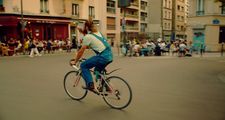 |
| Elisabeth Vogler on co-screenwriter François Mark: “He wrote poems too, and he is the one who plays the scene. He’s on the bike.” |
EV: First of all, thank you so much for this. It was not that easy, because the situation is more clear now. But back in the day, it was the first lockdown in France, and we just saw this amazing film by Richard Linklater, Slacker, because it was shown in a cinema at the beginning of 2020. So we saw that and during the lockdown we thought of the idea of making a sort of Slacker, but after Covid. So at that time, the present and the past and the future were not clear at all, because we didn’t know how we were going to be able to manage something in this period. We didn’t know what the future would be like.
We were just trying to stop for a moment and to think and talk and see what is important in our life, what was important in the past and what we would love for the future. We were trying not to make presumptions or write the future. We just didn’t have the tools for that. It was very strange to try and find the feeling of this time. That was the goal of our script to find a feeling and a way to express that in the moment. I think cinema can really talk about what we’re living now. We tried to never really talk about Covid, like use the word, because we didn’t want the film to be too dated to this area. For us it’s just what we experience during that time in this place in the world.
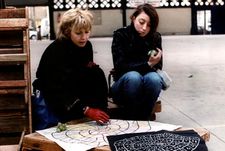 |
| Bulle Ogier and Pascale Ogier in Jacques Rivette’s Le Pont Du Nord: “I think Rivette also filmed this area in Pont du Nord because it’s more wild than the normal bourgeois Paris.” |
AKT: The first of the sequences includes hypnosis, which is so appropriate, because your film in one long take, hypnotizes us. We are with that character, we are hypnotized. Julie [Alice de Lencquesaing] runs away [from Leon], but we take her place and follow along. I also thought of a scroll that is unfolding - starting with the Louvre, then the river Seine, ending in the park - it’s a beautiful map. How did you figure out which sequence comes when and where?
EV: The hypnosis thing was that I think cinema is much more like hypnosis. We go into it and we just don’t let our eyes go out.
AKT: From Dr. Caligari onwards!
EV: Yeah! So it was very important at the beginning to have this sequence of hypnosis. For the rest of the sequences it was more organic. For example, the beginning was in the very historical neighbourhood, the Louvre, the Seine, and then we go up and to the more popular neighbourhoods. It’s not the suburbs, we’re still in Paris, but more popular in a way. First of all we thought about the map where we wanted to shoot, after that everything came organically. It wasn’t a lot of discussion about that because everything fit together. At the end we had to build one or two sequences, for example the guy on the bike [François Mark] with the poem. It was an addition in the last week, because we needed this portion to be filled. One of the screenwriters, he wrote poems too, and he is the one who plays the scene. He’s on the bike.
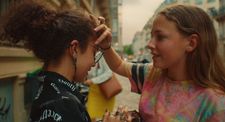 |
| Lilou and Lila excitedly try out the stolen makeup |
AKT: It’s his poem?
EV: Yes. It was very organic, but for example the sequence in the Métro, it was very stressful, because some subway stations were closed in Paris at that time. So the subway station we wanted, République, opened the day of our first shooting. We made a lot of bets for the shooting. And finally it paid off, so it was very cool. The whole film is in that light - we believe in something and in the end, I don’t know why, but it works. We never thought this would be a film. First it was just kind of experimentation. For me as a producer, I’ve worked on a previous film [Paris Is Us] and we sold the film to Netflix and we got some money. For me cinema is fun. I do that because it’s fun and something very exciting. So during Covid and lockdown, I said, okay, let’s try this. I will put some money in this, there’s lots of chance I will never see my money back, but it’ll be fun to try. So we tried. But at no moment were we sure it would work, unlike a more industrial film with financiers and precise production in the industry way. So the whole film is on that path.
AKT: It feels organic, and it’s so interesting that it does, because the conversations jump from Anish Kapoor [by Ambre and Blanche] to “50 summers left” for the characters [David and Mehdi] in the next sequence and on and on to different thoughts while people stroll through the city. I want to talk to you about the one in the Métro. It’s the first time masks are put on [by Léo and Zoé]. Before everybody seems to be so happy to be outside, then they put on the masks. When the disturbed woman [Marie] begins to speak to the two people talking, the camera stays on her. We never see their reaction to her. Being in New York, I don’t know if you’ve taken the subway here?
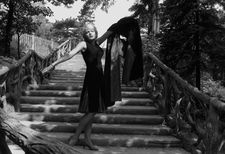 |
| Elisabeth Vogler on Corinne Marchand in Agnès Varda’s Cléo De 5 À 7: “For me the sequence in the park in Cléo is amazing. It’s always been a reference to have that feeling.” |
EV: Yes.
AKT: It’s a situation where you are very tense. Can you talk about the decision to stay on her and never show anybody reacting?
EV: Yeah, that’s interesting. That was one of the most challenging parts, because for the actress it was very intense, too, to bring this character to life. I think in real life we tend to not look at these people and tend to ignore them. So in the film I thought it was very interesting to stick with her. What is her world? What is she looking for? Can we look at her for like five minutes? Maybe it’s boring for some people, but it’s her world and maybe we can experience it too. Because cinema is more experiencing people’s lives. Since we are experiencing different lives, this one is important, too.
AKT: It was definitely the opposite of boring. Film history also is always lurking in associations. The fact that she is looking for Gare du Nord, suddenly in my head I had to think of Le Pont du Nord, the Rivette film. Bulle Ogier also walking in the city.
EV: I didn’t think of that, but it’s funny, the north of Paris is also wilder than the south. What we wrote in the beginning was very different. She was a lady, searching to buy drugs. It was a big monologue, but we decided to cut all the text. In the end we just kept Gare du Nord, because she wanted to go up north. I think Rivette also filmed this area in Pont du Nord because it’s more wild than the normal bourgeois Paris.
 |
| Elisabeth Vogler on Elsa Guedj, who plays the bride: “She is a stage actress, she took it as a stage.” |
AKT: And the fact that it all takes place outside, it’s an interesting match. Then you have a sequence of the two little girls [Lila and Lilou] who do each other’s makeup at the same time, something I’ve never seen before. Then comes the bride [Elsa Guedj] sequence which is hilarious, absurd. The conversation with the baby! Again you make the choice not to show us the woman who gives her the cigarette. Again, there are all these choices, whom we follow and where we don’t go. Can you talk a bit about the bride sequence?
EV: It was one of the first. It was written by Noémie Schmidt. Basically all of the screenwriters, apart from me, they are all actors in the film. So basically they wrote a lot of sequences but usually they don’t appear in the sequence they wrote. So Noémie wrote it and in the beginning it was very different. There was lots of baby and there were the parents and all. And we tried to realize the sequence with the actress Elsa Guedj and at the end it was better if she was just alone, doing stuff.
AKT: Great line to the baby “You were right to ditch your parents!”
EV: Yeah, we got rid of the parents. I think there is like an inversion in this sequence. The bride is not left on the side. She decided to abandon her future husband. But the baby did the same, this is how she thinks. It’s so funny that Noémie could think about it. After that we just found this spot for her, little flowers and lots of people behind her. And she is a stage actress, she took it as a stage.
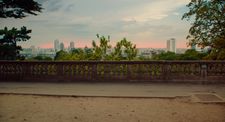 |
| Elisabeth Vogler’s Années 20 |
AKT: It leads to one of the scenes that seemed the most dangerous: when she hitches a ride on the scooter [driven by Guillaume] and they go by that garbage truck. I went oh, no, how on earth did you film this! Was it dangerous?
EV: No, it was not dangerous physically, but it was dangerous in the sense that we could have lost the shot. We know that it can happen, because there is no way that we can plan the garbage truck there at that moment. Because I was behind the scooter with the camera, and the guy who was driving the scooter, he managed to pass that. I kept talking to him, like the odd sentence. We did some sound in post-production, especially for this one because of the sound of the scooters. So you don’t hear me, but I keep talking to him, encouraging him to pass. It was not easy with the camera and challenging but it was very fun to shoot.
AKT: The flow is smooth - next come the chess match [Mehdi], the comedian who wants to become a masked dancer [Edouard], then we get all the historical background about Belleville [discussed by Gary and Mat], which is great. Near the end, which I found very interesting, we lose the people. You end in a park. Again film history came floating in. I was thinking of Agnès Varda’s Cléo De 5 À 7. Cléo is also in a park, a different one, but a park near the end. You explain that the park has the purest air and then show simply grass as if the camera was searching for the next person to follow.
 |
| Agnès Varda shows Anne-Katrin Titze her boat Photo: Anne-Katrin Titze |
EV: Wow, first of all, thank you, because Agnès Varda is one of my favourite filmmakers and Cléo is the film that led me to cinema ever since I saw it as a teenager. So for me it’s always been like a reference. This is not my version of Cléo, but it’s shot at the same time, the end of the day, a summer day, as she did in Cléo. For me the sequence in the park in Cléo is amazing. It’s always been a reference to have that feeling. It was also for us a way to go back into nature at the end of the day. There is the city with all the people and we go back to nature, which is really important in what we are looking for in the city. At that point I felt the film needed to breathe. We needed a little breathing, a little stop before the next person. When we wrote the film, we thought of Wim Wenders’ Wings Of Desire and the camera could be like an angel coming. So at that point the camera is just wandering around and finds these girls [Jeanne and Elise] and we get this tarot reading. And she is looking up directly to the camera because the camera can be anyone.
AKT: I am thinking about this now, there is also this little short by Agnès Varda about the tarot reader, Le Lion Volatil, it’s called.
EV: I remember the opening sequence in Cléo is that she gets the tarot reading.
AKT: Yes, of course, I forgot.
EV: And the woman, she saw death, because she saw she will get cancer. This is at the beginning that the whole dramatic narrative is based upon. Yes, I did think about that, but we try to do something different, because it’s not determination, that reading. She says you can do anything you want with that, It’s just like an indication.
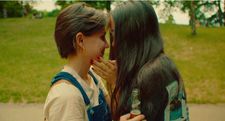 |
| Jeanne (Léa Moret) with Elise (Elise Tilloloy) after a Tarot reading in Les Buttes Chaumont. |
AKT: But then comes the story of the Viceroy of Sardinia whose dream protected his people from the plague. The sentence which probably inspired your title startled me. “A century only starts in the 20s.” That is a wow sentence, especially now that we are in 2021. Did the sentence come from one of the writers?
EV: I wrote the film with the three people I live with also in a big house in the suburbs of Paris, so we’re all friends and we’re all thinking about the present. There’s lots of things in the arts and music that look a lot in the past. In music there’s a lot of going retro and sometimes in fashion, too. And sometimes in cinema we tend to look too much in the past. In the past there was Nouvelle Vague, very strong cinema movements, and we tend to think that today there is nothing to do. So basically we wanted to point to that we can be in the present. You can look in the future and the future is exciting. We live a difficult moment but it’s also exciting, the challenge. We can take that and not be stuck looking too much in the past. First it was very important to look at this with a big smile and something positive so we look back at our century. I don’t know where I heard this sentence, but it was not from me, the theory that the century begins in the 20s. I think I heard that from a friend who heard that from a teacher somehow. We think it was a good thing to believe.
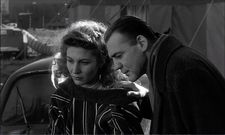 |
| Solveig Dommartin and Bruno Ganz: “When we wrote the film, we thought of Wim Wenders’ Wings of Desire and the camera could be like an angel coming.” |
AKT: Thinking about the 20th century, yes there were the Roaring 20s. But what about the First World War? Is World War I of the 19th century? Are we discarding the war or is it the beginning of it? This theory definitely gives you food for thought. Your film does that in so many ways.
EV: For me it was to be able to talk about what we are living. My previous film was also about that feeling too. It was more elaborate in the manner.
AKT: Paris Is Us?
EV: Yeah, this one is maybe more straightforward. For me the present is the most important thing. Our challenge as filmmakers is to bring people to cinemas, to theatres. I find that in my generation and maybe in the generation of my little sisters and cousins, they tend to watch lots of series, lots of TV shows, which I think are great. But I think only cinema can give the feeling of the time we live in. So for me it’s really important to bring exciting films about what we’re living now, so cinema can be bright and talk to people.
AKT: Cinema is unique in respect to the big screen. I really wanted to see your big musical number on the big screen. This is the magic of cinema and what is hypnotizing us. Thank you!
EV: I’m really happy to have done this interview with you.
AKT: How long are you in New York for?
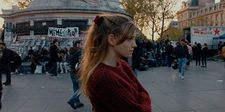 |
| Noémie Schmidt in Elisabeth Vogler’s Paris Est À Nous |
EV: I’m here since a week and I’m leaving on Sunday. I’m enjoying New York. This is my first time, so I walk around in the city. It would be very good to do a Roaring 20s in New York, too. I would love to! All the people, different lives.
AKT: A little thing about the English title - the apostrophe for the s shouldn’t be there.
EV: Wow! Oh thank you so much! The sales agents made the choice of this title. Because in French it’s The 20s [Années 20] basically. I’ll tell them, thanks. Nice to speak to you, goodbye.
Roaring 20s is available to stream on demand through Wednesday, June 23.
This year's Tribeca Film Festival has moved from its regular spring dates in response to the pandemic and will run through June 20. There will be in-person and drive-in events and, for the first time, the festival will have venues across the city's five boroughs.





















